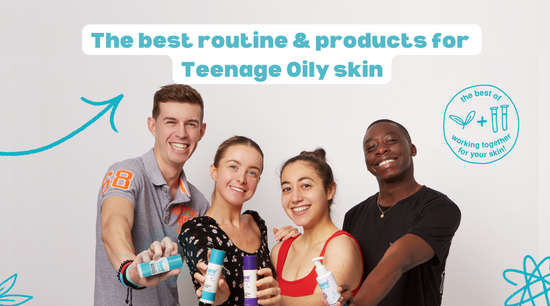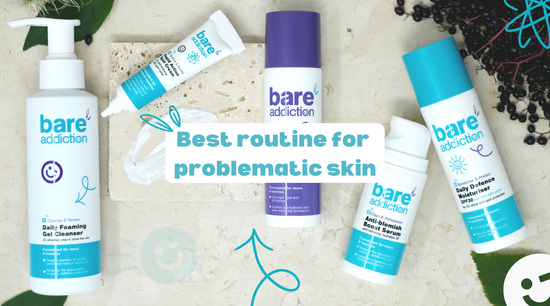Skincare for Teenagers - breakdown on products & ingredients
Skincare for teenagers, is a crucial aspect of overall health and well-being, as the skin is the largest organ of the body and it’s also the first line of defense against harmful environmental factors. It’s essential to take care of the skin during teenage years, as this is when the skin is undergoing rapid changes, and it is also the time when many common skin issues, such as acne and blackheads, tend to appear.
When it comes to skincare for teenagers it's important to remember that teenage skin is different from adult skin. Teenage skin is typically oilier and more prone to breakouts due to increased hormone production during puberty. It's also more sensitive and prone to inflammation, which can make it more susceptible to damage from harsh skincare products.

Skincare Routines for Teenagers
When it comes to finding skincare for teenagers, let us take the guessing work away, and shop our routines designed for oily, spot-prone and sensitive skin. Developed with dermatologists we have thought about every aspect of skincare for teenagers, including the products, ingredients and the routine their skin requires. We have 3 step routines for those wanting a quick and easy routine, to a 5 product AM&PM routine that helps control excess oil and breakouts.
In the UK, key dermatological and health organisations emphasise the significance of maintaining a consistent skincare routine for managing acne and other teenage skin concerns effectively. The British Association of Dermatologists highlights that regular application of acne treatments and skincare products can significantly improve skin condition over time. The NHS also supports this view, advising on the importance of consistency with skincare for teenagers, highlighting daily cleansing and treatment adherence helps reduce acne flare-ups and promote overall skin health.
Skincare Ingredients for Teenagers
When it comes to skincare for teenagers, selecting the right ingredients is not just about addressing immediate concerns like acne or oiliness; it's about setting a foundation for long-term skin health. Recent studies in the UK have underscored the significance of ingredient choice in skincare for teenagers, highlighting the need for formulations that address the unique hormonal changes and environmental exposures this age group faces.
UK research emphasises the synergistic effects of combining key ingredients like salicylic acid and niacinamide across different skincare products to effectively target acne-prone and oily skin. The British Association of Dermatologists advocates for a multi-step skincare regimen, incorporating both these ingredients for their complementary benefits in reducing oiliness and combating acne. Moreover, the NHS suggests that incorporating products with hyaluronic acid in skincare for teenagers can further enhance routines by providing necessary hydration without exacerbating oil production, proving that a balanced approach is key to managing acne effectively.

Understanding the active ingredients in your skincare is crucial to navigating teenage skin challenges successfully. Here are some key ingredients to include in skincare for teenagers:
- Salicylic Acid: A study published in the British Journal of Dermatology outlines the efficacy of salicylic acid, a beta-hydroxy acid (BHA), in treating acne by penetrating deep into the pores to dissolve debris and excess oil. For skincare for teenagers, this ingredient is commonly found in cleansers and moisturisers.
-
Succinic Acid:
Recent research published in Applied Microbiology and Biotechnology highlights the benefits of succinic acid in treating acne, making it a promising ingredient for skincare for teenagers. Its antimicrobial, anti-inflammatory, and oil-regulating properties address the core issues of acne-prone skin. It's natural origin and effectiveness in managing acne without harsh side effects underscore its potential as a key ingredient. - Azelaic Acid: Featured in research by the British Journal of Pharmacology, is celebrated for its antibacterial, anti-inflammatory, and pore-unclogging capabilities, offering a multi-pronged approach to treating acne and rosacea, making it an invaluable component in skincare for teenagers.
- Niacinamide (Vitamin B3): The importance of niacinamide in skincare for teenagers was highlighted in the Journal of Cosmetic Dermatology showing that niacinamide not only helps to build skin proteins (rebuild the natural barrier) and lock in moisture but also has anti-inflammatory properties that can reduce redness, irritation and excess oil.
- Hyaluronic Acid: This ingredient's role in skincare for teenagers is supported by its unparalleled hydrating properties, as detailed in the Dermato-Endocrinology journal. It's essential for maintaining the skin's moisture barrier, and particularly beneficial for teenage oily and acne-prone skin.
- Jojoba Oil: The role of natural oils in skincare for teenagers, particularly jojoba oil, has been re-evaluated by experts. Jojoba oil's, unlike other oils, has a high similarity to the skin’s natural oils, as discussed in the International Journal of Molecular Sciences, which allows it to provide moisturisation without exacerbating oiliness, offering a soothing solution for teenage skin.
Skincare Products for Teenagers
Selecting the right skincare for teenagers is vital, as their skin undergoes significant changes due to hormonal fluctuations, leading to acne, increased oil production, and sensitivity. Scientific research underscores the necessity of choosing not only the right ingredients but the right types of products.
Given teenagers' susceptibility to UV damage, using a day moisturiser with SPF is critical, and is often missed when choosing skincare for teenagers. The British Skin Foundation recommends broad-spectrum sunscreen to shield against UVA and UVB rays, preventing premature aging and reducing skin cancer risk.
Moreover, selecting a non-comedogenic night cream is an essential addition to skincare for teenagers, in order to support the skin's natural repair process during the night, as highlighted by dermatological research (NHS).

Understanding these key factors and selecting skincare for teenagers based on scientific evidence and dermatological advice can significantly improve the health and appearance of teenage skin, setting a solid foundation for skincare routines that promote long-term well-being. Some of the key products to include in skincare for teenagers are:
Gel Cleanser: Ideal for oily and acne-prone skin, a gel cleanser with salicylic acid can gently cleanse the skin, remove excess oil, and unclog pores without over-drying.
Day Moisturiser with SPF 30: Dermatologists emphasise this is the most important product to add to skincare for teenagers. Protecting teenage skin from sun damage is crucial. A lightweight, non-comedogenic day moisturiser with SPF 30 not only hydrates the skin but also provides broad-spectrum UV protection.
Night Cream: Night-time is when the skin repairs itself. A night cream is a key addition to skincare for teenagers, especially when formulated with ingredients like hyaluronic acid and niacinamide which can support the skin’s natural repair process, providing hydration and reducing inflammation.
Spot Cream: Spot treatments containing succinic acid or salicylic acid can target individual blemishes, reducing their size and redness without irritating the surrounding skin. A spot cream is a great product to add to skincare for teenagers, allowing for a quick and on-the-go treatment for pesky spots.
Serum: A serum packed with antioxidants and skin-loving ingredients like azelaic acid and niacinamide can address various concerns, from acne and sensitivity to hyperpigmentation, making it a versatile addition to skincare for teenagers.


